
In this our Golden Anniversary year, Supply House Times is going to pay special attention to operational excellence at all levels of the supply chain. This starts a series of “Best Practices” articles focused not on a single company but examining what stands out as unique and excellent among a variety of companies in the PHCP industry.
The “best practices” term is self-explanatory. Companies vary in their methods of handling the myriad operations of their business, which include purchasing, warehousing, billing, shipping, marketing and so on. We will examine various methodologies and highlight those that stand out from the rest as an effective business practice.
Best practices must be distinguished from business essentials that everyone must do simply to stay viable. For instance, master distributors must have plenty of inventory available in their specialty lines and they must be able to deliver it quickly when a customer needs it. Those are not best practices as much as necessity for anyone who wants to be in the master distribution business. An analogy would be the difference between fine dining on haute cuisine and eating simply to stay alive.
This month’s article focuses on master distributors, but many of their best practices are relevant as well to manufacturers, wholesale distributors, reps and anyone else in our industry’s supply chain. As the year progresses we’ll publish best practices in various other business categories as well.
Most of the best practices detailed here were gleaned from a recent visit to five master distributors in Southern California who graciously agreed to cooperate with us in sharing some of their operational best practices for this article - Bavco, Industrial Valco, Smith-Cooper, Specialty Valve & Fitting and Ta Chen.
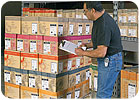
Boxed Valves & Fittings
Smith-Cooper International (SCI) isn’t entirely unique in putting commodities like valves and fittings into boxes, but they have taken the concept further than anyone else and made it their marketing signature. SCI has developed an elaborate system of standardized packaging they call “ProPack” to enclose most of the 24,000 PVF skus they sell.According to President Bob Cooper, ProPack allows distributors to store about 25% more material in a given amount of space. Product categories are distinguished by the size of their boxes, color strips and bar coding for standard master packaging along with an industry standard SPIN barcode for automated warehouses. An experienced warehouse worker can tell what’s on a shelf from a hundred yards away based on the boxes’ color codes. Each carton also has a comprehensive label on two sides of a corner for convenient reading, and each label has a picture of the product inside. “By putting a photo of the product on boxes, we are serving another purpose - almost subliminally teaching product knowledge,” said Cooper. “Most important, it helps to eliminate errors. Mistakes cost everyone money.”
SCI’s boxes also make it easy to palletize shipments, which in turn speeds up receiving for customers. Distributor customers frequently end up shipping the order right out the door to their customers without even breaking open a pallet.

Mirroring Customer Paperwork
SCI’s packaging system requires close coordination with multiple overseas factories and took years to perfect. Another best practice of SCI is simpler to implement. It’s a matter of will more than complex coordination.That is their practice of harmonizing packing slips and invoices with customer purchase orders. When goods arrive on a distributor’s receiving dock, workers typically check the shipments against a P.O. From the receiving dock the paperwork usually goes to the accounts payable department, where a payables clerk again is obliged to check that the goods delivered match what was ordered. Frequently, a master distributor’s packing slip uses different terminology, product numbers and chronology than what appears on the customer’s P.O., and that takes extra time to reconcile the paperwork. The invoice may also look different from the packing slip, adding another layer of confusion. Dissonant paperwork leads not only to inefficiency but the potential for costly mistakes. SCI does a couple of things to simplify the process and assure accuracy:
1. SCI uses customer product codes and organizes line items on packing slips and invoices in the same order as they appear on the customer’s P.O.
2. Pallets are packed in the same sequence as the items appear on the packing slip. When an order gets pulled, SCI warehouse personnel put it on a pallet in reverse order of the way it appears on the P.O. So the first item pulled off the top of the pallet will be the first item on the packing slip and down the line. For the customer, this eliminates the need to break down pallets and spread the materials on the warehouse floor to figure out what was received.
“As our industry has evolved, logistics is becoming a bigger and bigger part of what we do,” said Cooper. “The cost of labor is more than what a lot of our material costs, and you can’t be profitable handling it three or four times. So we have focused on putting together a program to help our customers operate more efficiently.”
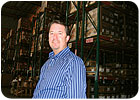
Internet Selling
Stainless steel master distributor Ta Chen has harnessed the marketing power of the Internet in a way matched by few companies in our industry. Go towww.tachen.comand the first thing you’ll see is a simple entry page with a customer login screen smack dab in the middle. Registered users can get connected to a hub of commercial activity that enables the master distributor to process some 2,800 quotes per day, and fulfill hundreds of orders - with a sales staff of merely 40 people.Registration numbers are assigned to each user in a customer company, and they have access to a large amount of information needed to guide almost any buying decision. They can see how much of every product carried by Ta Chen is in stock and at which location, shipping status, what’s on the water coming in from overseas, when it will arrive, and of course, the price charged to that customer based on a structured pricing matrix. (See following best practice.) Customers using the Web site can drill down further to obtain details such as background information about the manufacturer of each item and material test reports.
Companywide, about 70% of all Ta Chen orders are fulfilled over the Internet - and a whopping 90% in its home Southern California market. National Sales Manager Danny Nu remarked only half jokingly that his salespeople don’t sell PVF as much as they do the company’s Web site. In addition to sales commissions, Ta Chen’s sales staff can pad their earnings simply by registering new users on the Web site and even for keeping e-mail addresses up-to-date.
Customers benefit from transparency and efficiency. The benefits to Ta Chen include an enormous amount of data that can be mined for marketing purposes. For instance, a given product line might show an abnormal imbalance between the number of inquiries quoted and orders booked. That tells the master distributor the item’s pricing may be out of whack or something else isn’t right.
The real-time Web data gives company leaders a snapshot of how Ta Chen is doing day-by-day, hour-by-hour. Company President Robert Shieh is said to peek at the numbers two or three times a day. Managers can respond to customers via e-mail, save quotations, forward them to colleagues, and even do an online credit check. “We do a tremendous amount of business on weekends,” said Vice President Jeff Larson, remarking on the Web site’s 24/7 availability.
Data can be diced in various ways and reports generated instantaneously. Salespeople can tell at a glance who is buying what - and who isn’t buying, despite regular quotation inquiries. This gives them something to talk to the customer about.
Despite all the detail, Ta Chen’s system has a user-friendly simplicity about it. It’s easy to navigate and intuitive to any computer user. The software for this system was customized by Ta Chen based on a Microsoft spreadsheet. Development began in 2000 and has been tweaked ever since to something close to ideal.

Structural Pricing
Going hand-in-hand with Ta Chen’s Internet marketing is a structured pricing matrix that eliminates the hassles and uncertainty of price negotiations.Ta Chen’s system pegs a sale price for every customer inquiry based on that customer’s purchase volume, bundling and a variety of other factors such as credit worthiness, pay history and shipping demands. No further negotiating takes place.
“Good customers like this system,” said Larson. “They always ask for the ‘best price,’ and they trust our pricing to be the best they’re entitled to based on loyalty, how much they buy from us, how fast they pay and so on. Also, with this system everyone in a company will get quoted the same price. It doesn’t vary with who calls or who the inside salesperson might be.”

Will-Call Marketing
The five master distributors we visited in the greater Los Angeles area all do a significant amount of will-call business. One of them, industrial PVF master distributor Industrial Valco, gets about half of its business from pickup orders.Industrial Valco’s pickup area resembles a retail store with large banners advertising the product lines carried by the company. A valve rack got placed far forward near the counter “because we wanted to show the breadth of what we do,” said President Rob Raban. “A lot of customers come in here to pick up simple fittings and don’t realize all that we offer. So we show them some 30-inch cast steel gate valves to look at. It gives our warehouse a marketing component.”
Another aspect of will-call marketing that gives them an edge is 24/7 after-hours service. Customers requiring after-hours service pay an opening fee, which the company splits with the person on-call to open up. It’s a valuable service in particular to industrial MRO customers who stand to lose a lot of production when a system goes down. Last year they handled more than 500 after-hours calls.
Large bay windows separate an office area from the pickup counter. They enable Regional Sales Manager Vernon Preston and other office personnel to look out into the pickup area. This discourages theft, and another subtle benefit is seeing what’s in the back of customer pickup trucks. “If they’re loaded up with weld fittings they didn’t get from us, it might prompt a call from us trying to find out why,” said Raban.
Founded in 1947 by Raban’s grandfather, Industrial Valco proved to be a treasure trove of best practices. Not everything they do qualifies as man-bites-dog headline news, but success often is the cumulative effect of a lot of little things done well.
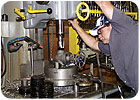
Machining Special Orders
Industrial Valco and another master distributor we visited, stainless industrial PVF specialist Specialty Valve & Fitting, operate on-site machine shops that give them the ability to come up with almost anything a customer might need in a pinch even if they don’t carry it in stock or are out.Operations include taper boring, flange facing, drilling and tapping, valve modification, as well as pipe threading and grooving. “If you can draw it, we can make it,” said Raban. Machining capability is a value-added service for customers and also reduces the amount of oddball inventory a master distributor needs to carry.
Titles That Fit The Task
Industrial Valco operates seven facilities stretching as far east as New Jersey. Managers of those facilities are given titles of regional sales managers rather than branch managers.Raban explained: “A lot of them came up through the warehouse and managed all the operations of those facilities. Now they have to grow into a new role that may be outside of their comfort zone, which is building sales throughout a region. I want them to focus on that and give up operational duties in the branch. Let the warehouse manager do that job. This elevates both the regional sales manager and the warehouse manager.”
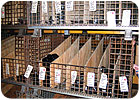
Hot Dog Fridays
Master distributors have trouble taking clients to lunch. That’s because their main customers aren’t the top executives and managers. It’s more likely to be the inside sales staff or counter personnel who need to call them in a pinch. There may be a dozen of them or more, and turnover brings new people into the picture constantly.Easier and less expensive than rounding up all those folks is to invite them to come to you for lunch. For about $40 a day, Industrial Valco serves hot dogs and trimmings every Friday in the summer, typically drawing 20-30 visitors. Last summer they cooked some 1,700 hot dogs, all the while showing off their wares.
Guided Tour Open House
This reporter has attended scores of open houses in a 30-year industry career. Among the most memorable was the event hosted by Industrial Valco last October to show off their new headquarters. It was a festive occasion with an “Uberfest” theme taking off on Octoberfest celebrations, but what really made an impression was how artfully they blended purposeful marketing with the fun.Festivities started with visitors taken in small groups on a guided tour of the facility, beginning in a conference room with a video about the company’s history and business practices. Then the tour snaked its way through the warehouse with explanations along the way about the company’s product lines and way of doing business. About a half-hour later the tour ended with pretty costumed models serving beer and brats in harmony with the event’s Uberfest theme.
That’s the way to do an open house, I left thinking. This went beyond free suds and sausage. I actually learned quite a bit about their business.

Sensible Storage
Conventional wisdom holds that warehouse aisles need to be at least 14 feet wide to accommodate forklifts. But a lot of smaller product doesn’t require forklifts for picking. Industrial Valco has arranged its warehouse with smaller items consolidated into aisles 4 to 5 feet wide, leaving the 14-foot aisles for bigger valves and fittings. It’s an effective use of assets.Another best practice dates back more than half a century to the company’s founding. Rob’s grandfather determined that wire mesh baskets were an ideal repository for small diameter fittings and flanges. And that’s the way they’ve done it ever since.
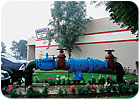
Find The Ultimate Niche
Businesses don’t get any “nichier” than Bavco’s. Bavco is a master distributor specializing in backflow preventer repair parts. They handle components of some 1,800 different backflow prevention assemblies made by 22 manufacturers. Bavco has a nationwide reach with few competitors. Those that do compete against Bavco tend to sell only regionally - and many of them are also customers of Bavco.Three complexities prove a formidable barrier to entry in this business. First is the need to stock everything that conceivably could be needed to repair those 1,800 different backflow devices. “We’ve got parts we’ll never sell,” said Jim Purzycki, the company’s jovial owner and president. “Someday when they tear down this building someone will discover something that makes him scratch his head and wonder what the heck is this! But we have to have it. There are many items we carry for which the proper stocking level is one. I panic when someone finally buys one of those, because what if someone else calls for the same thing before we can get another one!”

Also central to master distribution is a large customer base. True for all master distributors, it goes double for a quirky niche like Bavco’s. Their active customer list numbers a little over 4,800 names. “The good news is I don’t have any really big customers,” said Purzycki. “Nobody can hurt us by going bankrupt. But we need a really big base to survive.”
And that is the third big barrier to entry protecting Bavco’s market niche. Building that customer base is a slow, laborious task. Purzycki showed me a list containing more than 70,000 names of potential buyers. Besides wholesaler-distributors, they include various government bodies such as municipalities, military bases and so on. More than half of those names may no longer be viable, but that still leaves an enormous amount of people to reach.
Advertise, Advertise, Advertise
Alright, let’s get it on the table, this best practice is self-serving to the max. Bavco and most of the other master distributors in this industry regard advertising in Supply House Times as a major marketing component. They need to do it in order to build a large customer base that is essential to the master distribution business model, and to retain those customers.I asked Purzycki what’s the most difficult part of his business, and he responded without hesitation, “getting people to remember us.” Theirs is the type of business where orders are few and far between. Someone who bought a part from Bavco a year ago won’t necessarily remember the name when the same need arises again. Sometimes a backflow preventer breaks down and nobody in the loop even knows a company like Bavco exists to bail them out.
Then there is the problem of personnel turnover. Bavco’s customers typically are not top executives and managers. They are inside and counter sales personnel, of which turnover and transitions run rampant. Consolidation has made it worse, as the large chains are always moving people around.
“Once we get someone’s name in our system, we’ll keep in touch with that person and won’t let him go,” said Purzycki. “But as personnel change, we lose our contacts. The CEOs and branch managers may still be there, but ‘our customer’ has gone and we have to start all over again with the successor.”
Eating Some Freight
Shipping costs are not a concern to most master distributors. Customers usually pick up freight charges and will specify whether they need overnight service. Bavco has a particular problem, however, stemming from those aforementioned regional competitors.When shipping across country, Bavco enacts a standard ground freight charge but ships overnight. This is to match the local competition in both speed and expense. Most of their orders are under 3 lbs. and will fit in a standard UPS pouch, so the excess charges aren’t great. And, as everyone in business knows, the customer always pays in the end whether directly or with the expense imbedded in the margin. Bavco has made a business decision to absorb a little freight expense in order to protect market share.
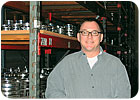
Old-Fashioned Service
Specialty Valve & Fittings is a small (14 employees) regional master distributor of stainless PVF that bumps heads against some very large competitors - notably Ta Chen, whose L.A. headquarters is just a few miles down the road. President Hal Spear remarks with tongue in cheek that they are “the most modern 1950s company around. We have the same priorities people did a few generations ago.”As noted earlier, a machine shop helps them provide customers with just about any product they need on a moment’s notice. They use computerized machinery with programs written for just about every part they could possibly produce. This took time to develop, but in the end, enhances the company’s value immensely.
Spear also drew attention to a number of practices that tend to separate his company from the pack.
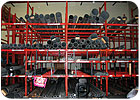

Common Best Practices Of Master Distributors
As a matter of semantics, everything cannot be the “best.” In visiting a bunch of master distributors while covering this story, I noticed some common characteristics that would seem to qualify as best practices, except virtually all of the master distributors we spoke with do them. Though not essential to the business of master distribution, these are some of the things I noticed that are common to many top master distributors.
